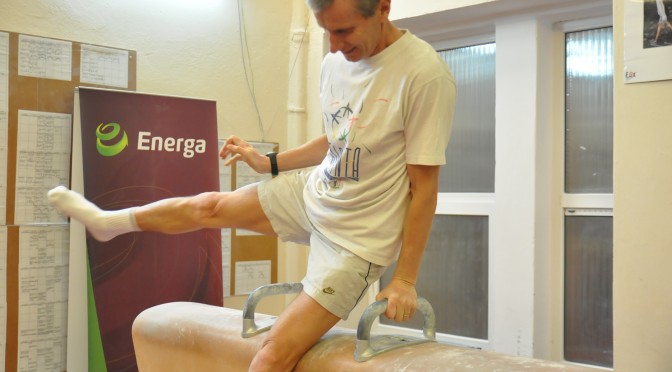Istnieje więcej niż jeden przepis na trening długodystansowy. Pomijam zawodowców i rekordzistów, bo się na tym nie znam, ale amatorzy mają bogate menu treningowe. Każdemu smakuje coś innego i na końcu wcale nie musi odbijać się czkawką. Są tacy, którzy biegają w równym tempie bez wielkich udoskonaleń dzień w dzień, inni urozmaicają trening interwałami, ćwiczeniami technicznymi, których mało kto lubi, ale i tak swoje muszą przebiec. OK, ale gdy wchodzimy w objętości 60km biegu tygodniowo, zaczynają trzeszczeć ścięgna, powoli tracimy ochotę na wysiłek, a dodatkowo zimowa pogoda nie nastraja, to trzeba coś zmienić.

Dobrze jest pójść raz w tygodniu na pływalnie, by ulżyć dobitym nogom, a jeśli płyniesz aktywnie i nie zalegasz przy ściance jak foka, to trening na podtrzymanie wydolności tlenowej masz zaliczony. Dobrze jest również znaleźć salę gimnastyczną, gdzie możesz się dobrze rozciągnąć, no i porobić trochę ćwiczeń ogólnorozwojowych.

Wzmacnianie innych partii mięśni jest kluczowe przy bieganiu … długim bieganiu. W końcu, na pewno siądą nasze resory i ciało zacznie telepać się na coraz sztywniejszych nogach. Ostatnie 30km do mety, będziemy toczyli się siłą woli, marzeniami o ukończeniu, ale również silnym brzuchem, plecami a zwłaszcza pasem biodrowym. W książce Scotta Jurka – jednego z najlepszych ultrasów świata – jest rozdział poświęcony poszukiwaniom metod treningu, które mogą poprawić jego wyniki, bo dalej jak 50-70km dziennie trudno biegać dzień w dzień, nawet Scottowi. Wymyślili taśmę gibbon.
Okazuje się, że chodzenie po niej wzmacnia układ biodrowy, stabilizuje krok i właśnie to jest kluczowe na końcówce – ostatnich 25km, kiedy metę już czuć tuż tuż, jesteś tak blisko, że już się nie chce zawiązać buta – z resztą jak tu się zgiąć po, np. 75km biegu. W innym źródle wyczytałem, że najlepszym treningiem jest ciągłe urozmaicanie i zaskakiwanie organizmu, który szybko przyzwyczaja się do powtarzalnych cykli i adaptuje, unikając wysiłku.


A propos ‘gimnastyki’ – po ukończeniu ultra 100km po Beskidach – (Bieg 7 Dolin), wlokłem się do punktu z masażem, licząc, że obok jest jakiś prysznic. Mili stażyści pokazali, że nieopodal jest wszystko co trzeba bym umył nogi. Wchodzę do kontenerowej łazienki i widzę, że umywalki są na wysokości pomiędzy moim pępkiem a piersiami – pewnie tak pomyślane, by nie nachlapać. Obok stoi zmarnowany ultras, który błądzi zrozpaczonym wzrokiem i kombinuje jak wsadzić nogę do umywalki na poziomie 1m30cm – niemożliwe. No i tak wzajemnie sobie pomagając umieścić kończyny na niebywałej wysokości, po chwili uzyskaliśmy status ‚czysty’, łazienka niestety została mokra.



Transaltion Anna Meysztowicz
Diversify training
There is more than one recipe for long-distance training. I am skipping professionals and record holders because I am not an expert in this, but amateurs have a wealthy training menu. Everyone likes the flavour of something different and at the end you don’t necessarily have to have hiccups. There are those who run at an equal pace without any great improvements day in day out. Others diversify their training with intervals, technical exercise that no one really likes but has to run their fair share either way. Ok – when we enter a level of 60 km run each week, our tendons begin to creak, we slowly lose the will to make the effort and additionally the winter weather doesn’t help our mood, so we have to make some changes. It’s good to go swimming once a week to soothe our exhausted legs, and if you swim actively and don’t hang around by the wall like a seal, then your training for maintaining oxygen efficiency is done. It is also good to find a training room where you can have a proper stretch and do some general exercises.
Strengthening other groups of muscles is key for running – long distance running. In the end our springs will likely collapse and our body will begin to shake on increasingly stiff legs. The last 30 km to the finishing line we will roll along by sheer willpower, dreams of finishing but also with the help of some very strong stomach, back and particularly hip muscles. In the book by Scott Jurk – one of the world’s best ultramarathon runners – there’s a chapter dedicated to the search for the training methods that can improve his results as it is difficult to run further than 50-70 km per day even for Scott. They invented the gibbon tape. It turns out that walking on it strengthens the hip system, stabilises the step, and that is what is key in the final 25 km when the finishing line is so so near that you don’t even want to tie your shoelaces – but how are you able to bend after, e.g. 75 km of running. I read in a different source that the best training is to constantly diversify and surprise the body, which quickly adapts to repetitive cycles and does so avoiding effort.
Concerning “exercise” following the ultra – after completing 100 km in the Beskid Mountains – the Run of the 7 Valleys, I dragged myself to the massage point, counting on there being a shower somewhere nearby. Some friendly interns showed me that, close by, was everything necessary to wash my legs. I walk into the container bathroom and see that the sinks are located at the level between my belly button and my chest, probably so as not to splash. A wrecked ultra runner is standing next to them, looking around desperately and wandering how to put his leg into a sink located at 1 m 30 cm – impossible. And so, helping one another to fit our limbs at an incredible height we gained the status of being clean. Unfortunately the bathroom remained wet.

